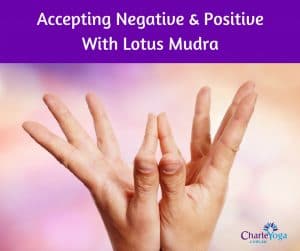 Author: Charley Hickey is a practicing yoga therapist and senior yoga teacher who runs group and private yoga classes in Applecross & Fremantle, Perth. She also runs specialised yoga workshops for yoga students & yoga teachers.
Author: Charley Hickey is a practicing yoga therapist and senior yoga teacher who runs group and private yoga classes in Applecross & Fremantle, Perth. She also runs specialised yoga workshops for yoga students & yoga teachers.
Accepting The Negative & Positive With Lotus Mudra
Acceptance is an idea that is sometimes misunderstood and usually stimulates hearty discussion when it’s brought up in groups of yoga students.
Acceptance is defined as a willingness to believe that something is true. Another interpretation is the realisation of a fact of truth and the process of coming to terms with it. (Encarta Dictionary: English UK)
Often I find acceptance is instead misinterpreted as apathy or complacency. Following this premise, instead of dealing with the truth, we might instead intentionally or unintentionally ignore it. This can cause a side stepping around emotions that might need to be dealt with and accepted. Moving on is almost impossible unless acceptance happens first.
Symbology of Lotus Mudra
This brings me to the symbology of the lotus flower and specifically the lotus mudra which is a hasta mudra or hand seal/gesture. The lotus appeals to me because it symbolises something beautiful growing from out of the mud and crap! It’s important to note here that at no point do we remove the mud and crap. We couldn’t if we wanted to anyway because it holds the roots of the beautiful lotus flower.
I am not trying to turn something negative into something positive, I don’t believe in doing that. The mud and the lotus, they both simply exist in their perfect oppositeness. Let’s face it, life can be crappy sometimes! Often we can’t change the situation we’re in and trying to do that can be an agonising process. To me the lotus symbolises acceptance that for the lotus to exist, so must the mud & the crap.
Practicing Lotus Mudra
We can use mudras in a variety of ways depending on individual preference. Some have great physical benefits for improving movement of the fingers and stretching out various parts. Others are particularly useful for focusing the mind when it is roaming wildly. On a more subtle level mudras work on the energetic yoga system and manipulate the flow of prana. This means they might change how we feel on an emotional level too.
To practice lotus mudra, sit comfortably either on the floor or in a chair. Bring the hands into Anjali mudra (palms together/prayer) at the centre of the chest. With the base of the palms together, touch the thumbs together and then the little fingers together. Invite the other three fingers to open as wide as possible, like a lotus flower opening. Place the hands in front of the heart with the thumbs facing toward the chest.
Start the breath practice with a floating lotus flower. Inhale and float the flower from the heart up to the forehead. Exhale, draw the palms closed into prayer, squeezing the hands together and taking the elbows out wide to the sides. The hands can lower towards heart level or lower in order to feel a stretch into the inner wrists area. Do as many rounds as you like along with the natural flow of your breath. If you’re not sure then 10 rounds can be a nice place to begin.
Acceptance Can Be Hard
Acceptance can be hard; dealing with crap is harder in the short term than pushing it aside or ignoring it. However, pushing it aside just creates a huge pile of it to deal with later! Reminding ourselves of that every now and again can hopefully help us to create some space for acceptance.
I look forward to sharing a few more hasta mudras in class this term if you are coming along!

